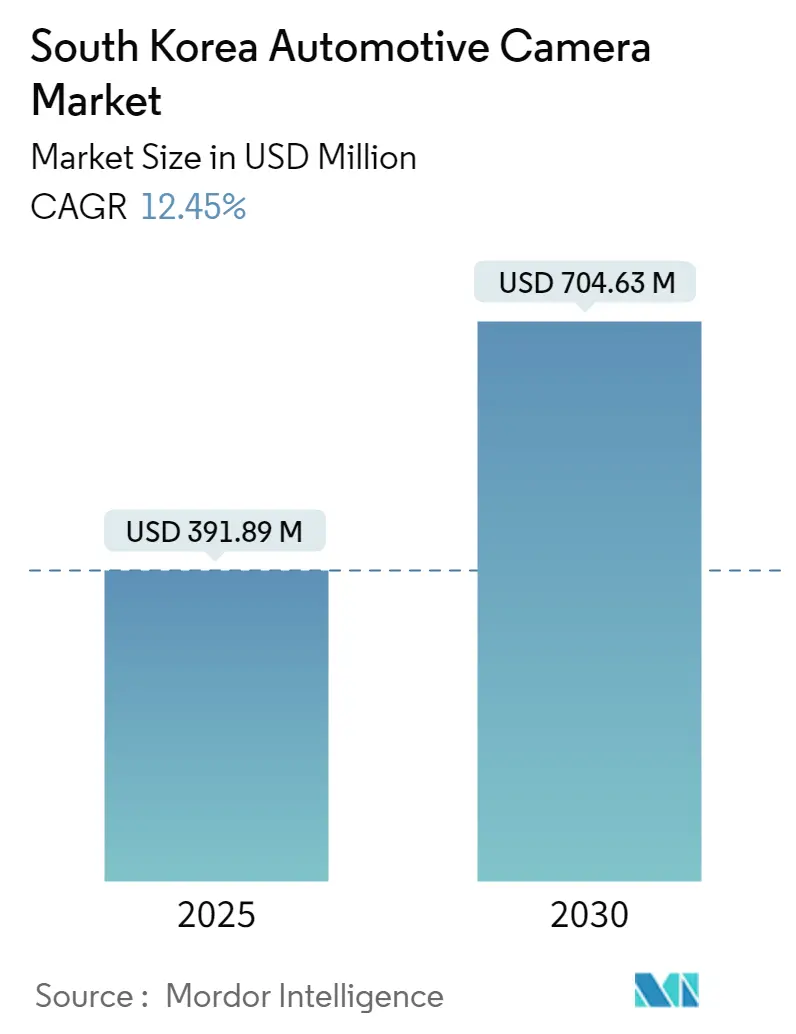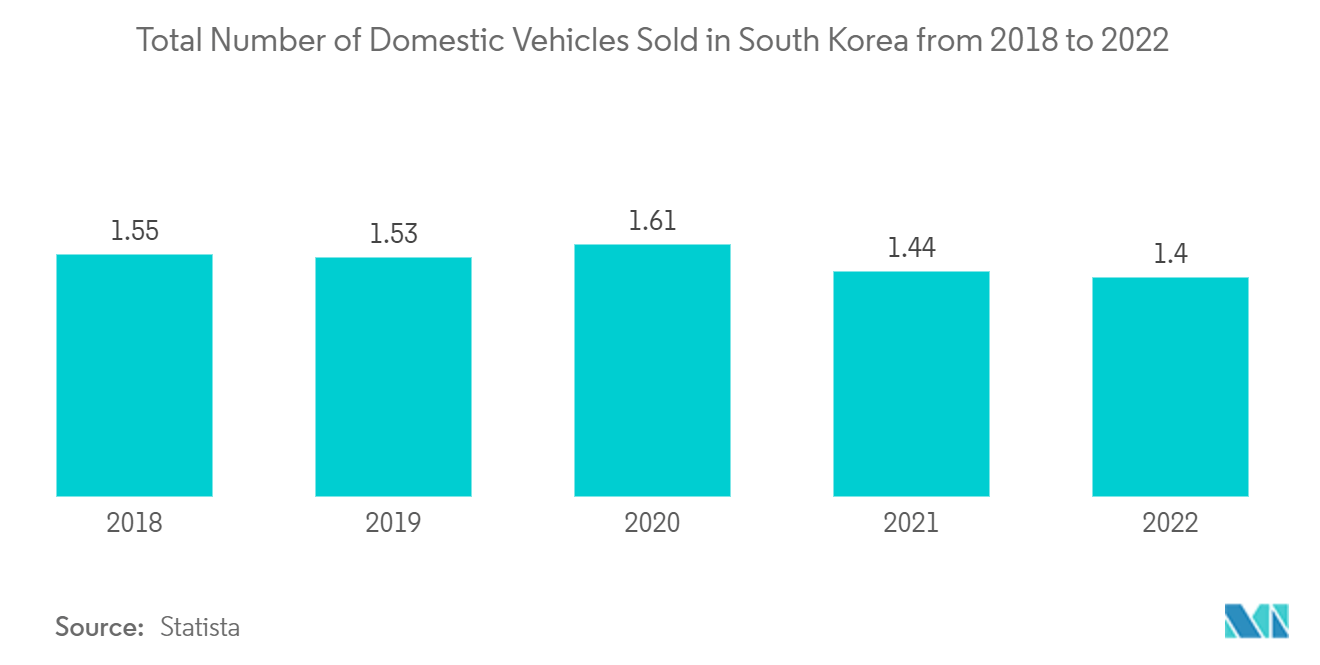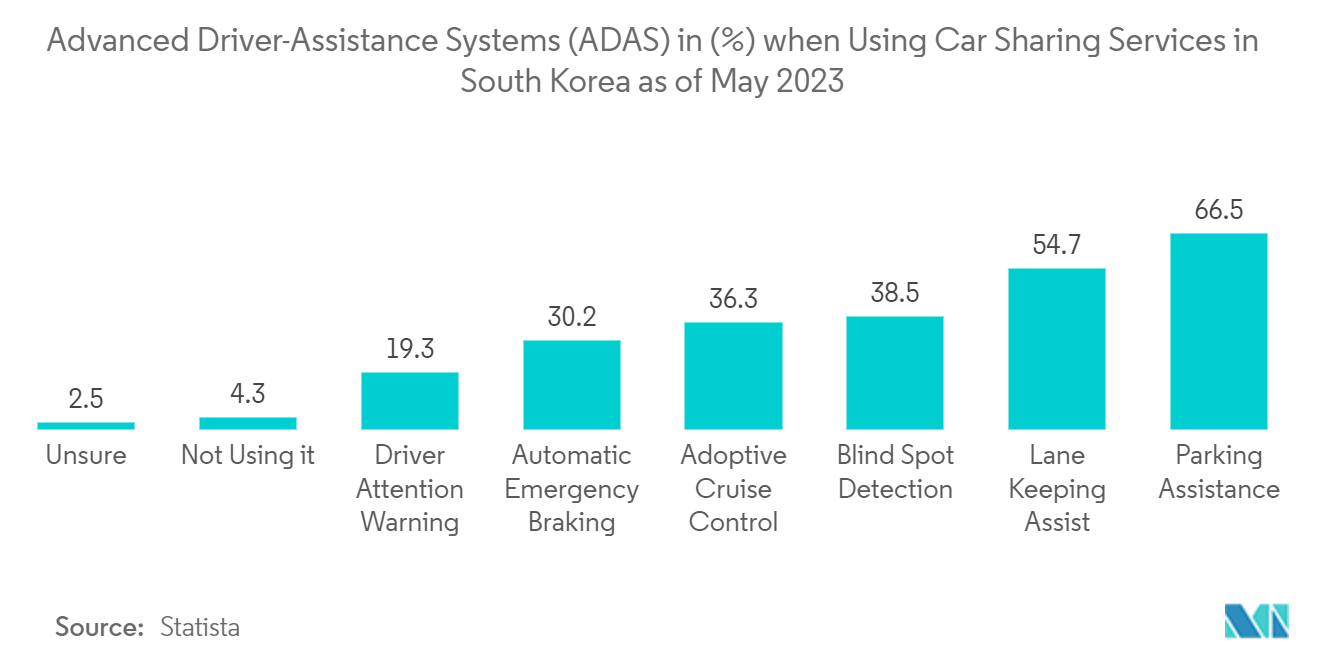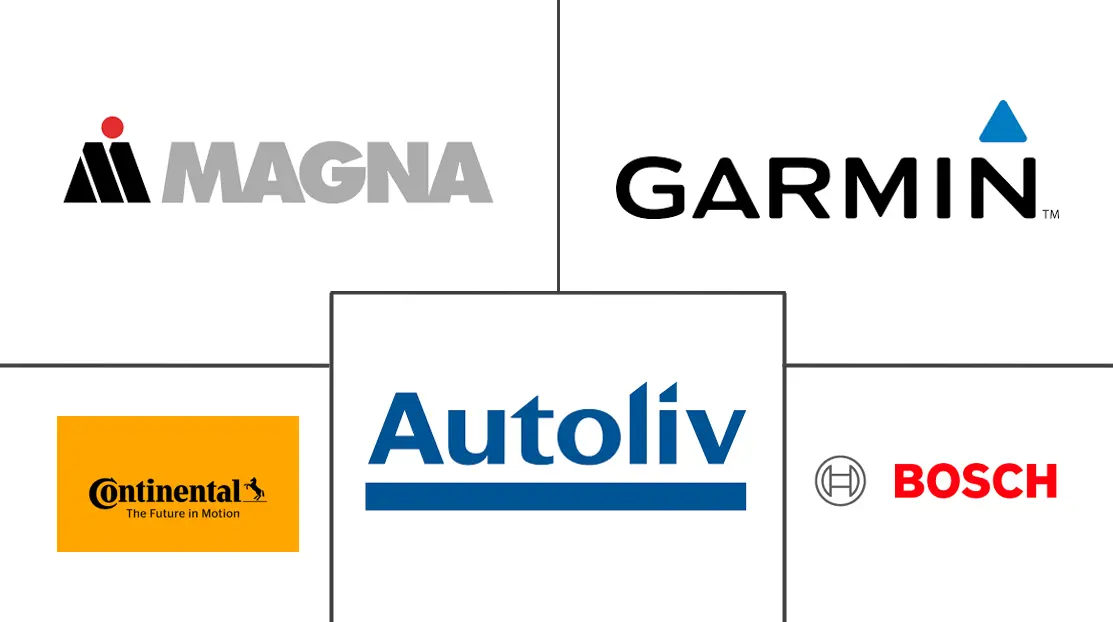
South Korea Automotive Camera Market Analysis by Mordor Intelligence
The South Korea Automotive Camera Market size is estimated at USD 391.89 million in 2025, and is expected to reach USD 704.63 million by 2030, at a CAGR of 12.45% during the forecast period (2025-2030).
Factors such as the increasing market penetration of premium cars, autonomous vehicles, and electric vehicles, as well as the rising safety installations per vehicle, are accelerating the demand for automotive camera systems. The automotive industry in South Korea is expected to continue witnessing rapid technological evolutions over the next few years.
The latest advancements in camera technology, such as 360-degree cameras that stitch images from multiple cameras and display a consolidated image on a split screen, automatic emergency braking, adaptive cruise control, and collision warning systems, are gaining popularity across South Korea. Mass production of camera units is expected to bring down the price drastically over the coming years. However, due to advanced technological requirements for production, new player penetration into the market remains a challenge.
The growing inclination of customers to achieve an advanced safety performance experience while driving is expected to fuel the growth of the automotive camera market. Furthermore, the surge in demand for passenger vehicles owing to a rise in disposable incomes and improved lifestyles is propelling the South Korean automotive camera market. During the forecast period, production is expected to register an increase in line with the abovementioned factors.
South Korea Automotive Camera Market Trends and Insights
Sensing Camera Segment to Witness the Fastest Growth
Systems using remote sensing cameras are gradually becoming an integral part of active safety systems in automotive vehicles. Sensing cameras provide a higher performance level than general-purpose driving cameras while also meeting the same automotive quality standards as more cost-effective solutions. These intelligent safety systems have two key components, namely, remote sensors that use remote sensing technologies and a processing computer.
A remote sensor is a device that collects data about real-world conditions through sensors such as radar, ultrasonic sensors, and cameras. The processing computer receives data from these cameras and sensors, then makes the decision and sends commands to the vehicle subsystems. A few advanced automotive camera companies in the country are introducing different business strategies to enhance their market offerings. For instance, in April 2022, ZF Friedrichshafen acquired a 6% stake in StradVision, a South Korean pioneer in AI-based vision processing technology for autonomous vehicles and ADAS systems.
With the increasing sales of automobile vehicles in South Korea, the demand for cameras has been increasing significantly. For instance, in 2022, around 1.4 million units of vehicles, including passenger cars and commercial vehicles, were sold in South Korea. Owing to the aforementioned factors, the market is expected to grow subsequently over the forecast period.

ADAS Application Segment Expected to Drive the Automotive Camera Market
The demand for automotive cameras is rapidly increasing due to their various applications in different ADAS functions. The country is following a roadmap to adopt level-4 autonomous vehicles by 2027. South Korea has a favorable environment for quick, accurate, and reliable protection through various systems, such as newly updated patent examination guidelines and accelerated exposure for autonomous vehicle inventions.
Furthermore, autonomous vehicle technology relies on sensor and camera technologies to perceive surroundings and navigate without any human intervention. Along with ADAS features, the country’s government and industrial participants are introducing various initiatives and entering into partnerships to produce autonomous vehicles. For instance,
In May 2023, the Korean Intellectual Property Office (KIPO) unveiled compelling findings from a global survey on patent submissions for camera-LiDAR sensor convergence technology. According to KIPO’s assessment, there has been a substantial surge in patent fillings for camera-LiDAR sensor convergence technology, witnessing an impressive average annual growth rate of 33.6% over the last five years.
The South Korean government is currently conducting preliminary feasibility studies for its level 4 self-driving project, which will be underway from 2021 to 2027. It also plans to launch a flying car demonstration project in 2025.
Also, the government will supply at least KRW 2 trillion (USD 1.49 billion) to increase the degree of independence in terms of major materials and parts required for future cars from 50% to 80% while helping train 2,000 researchers and engineers by 2025. Owing to these aforementioned developments, it is anticipated that the automotive camera market in South Korea will continue to grow over the forecast period.

Competitive Landscape
The South Korean automotive camera market is dominated by various international and domestic players, such as Garmin Ltd, Panasonic Corporation, Continental AG, and Denso Corporation. Major players in the market are launching advanced camera technology to stay ahead of their competitors.
- In April 2023, IRay Technology Co. Ltd, a China-based automotive camera industry player, presented its innovative technologies and highlighted thermal camera imaging products in Hall C Booths G201&203 at COEX 3F, Seoul, Korea.
- In December 2022, LG Innotek Co. announced plans to showcase autonomous car parts such as camera modules for advanced driver-assistance system (ADAS) technology, sensor fusion solutions, light detection and ranging (LiDAR) solutions, and 5G-speed Wi-Fi combo modules that optimize connectivity between cars and smartphones.
South Korea Automotive Camera Industry Leaders
Robert Bosch GmbH
Magna International Inc.
Garmin Ltd.
Continental AG
Panasonic Corporation
- *Disclaimer: Major Players sorted in no particular order

Recent Industry Developments
- September 2023: Hyundai Motor developed a technology to automatically remove contaminants from automotive camera sensors.
- May 2023: STRADVISION, an AI-based automotive camera and vision perception technology company, announced plans to open its autonomous driving workshop in Dongtan, Gyeonggi-do, Korea, to strengthen vehicle object recognition technology.
- April 2023: bitsensing, a leading South Korean provider of digital imaging radar technologies and cutting-edge radar solutions, announced a strategic partnership to develop 4D digital imaging radar to meet the needs of the largest automotive OEMs in Korea and significantly enhance safety on the roads.
South Korea Automotive Camera Market Report Scope
An automotive camera is a specialized electronic device designed for use in vehicles. It continuously captures and provides the vehicle driver with a view of their surroundings. The camera enables drivers to make better decisions based on real-time images of the environment that consider vehicle maneuvers, thereby helping drivers and offering an imagining system that improves vehicle safety. Automotive cameras can be installed inside or outside of vehicles, depending on the applications.
The South Korean automotive camera market is segmented by vehicle type (passenger vehicles and commercial vehicles), camera type (viewing camera and sensing camera), and application type (Advanced Driver Assistance Systems (ADAS) and parking). For each segment, market sizing and forecasting have been done based on value (USD).
| Passenger Cars |
| Commercial Vehicles |
| Viewing Camera |
| Sensing Camera |
| ADAS |
| Parking |
| By Vehicle Type | Passenger Cars |
| Commercial Vehicles | |
| By Type | Viewing Camera |
| Sensing Camera | |
| By Application Type | ADAS |
| Parking |
Key Questions Answered in the Report
How big is the South Korea Automotive Camera Market?
The South Korea Automotive Camera Market size is expected to reach USD 391.89 million in 2025 and grow at a CAGR of 12.45% to reach USD 704.63 million by 2030.
What is the current South Korea Automotive Camera Market size?
In 2025, the South Korea Automotive Camera Market size is expected to reach USD 391.89 million.
Who are the key players in South Korea Automotive Camera Market?
Robert Bosch GmbH, Magna International Inc., Garmin Ltd., Continental AG and Panasonic Corporation are the major companies operating in the South Korea Automotive Camera Market.
What years does this South Korea Automotive Camera Market cover, and what was the market size in 2024?
In 2024, the South Korea Automotive Camera Market size was estimated at USD 343.10 million. The report covers the South Korea Automotive Camera Market historical market size for years: 2019, 2020, 2021, 2022, 2023 and 2024. The report also forecasts the South Korea Automotive Camera Market size for years: 2025, 2026, 2027, 2028, 2029 and 2030.
Page last updated on:
South Korea Automotive Camera Market Report
Statistics for the 2025 South Korea Automotive Camera market share, size and revenue growth rate, created by Mordor Intelligence™ Industry Reports. South Korea Automotive Camera analysis includes a market forecast outlook for 2025 to 2030 and historical overview. Get a sample of this industry analysis as a free report PDF download.



